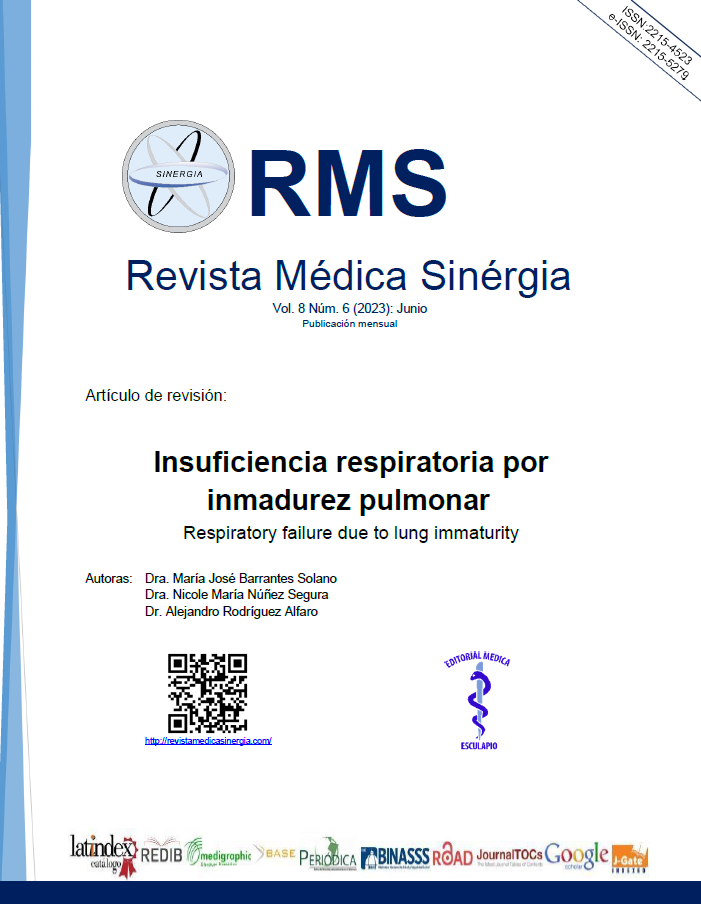Abstract
Neonatal respiratory failure is the inability of the respiratory system to support oxygenation, ventilation, or both, in newborn children. This is mainly triggered by respiratory distress syndrome (RDS), or hyaline membrane disease (HMD), associated with developmental immaturity in the production of surfactant factor. Neonates with respiratory distress are 2 to 4 times more likely to die than those without respiratory distress.
A clinical description, diagnosis and treatment of respiratory failure due to lung immaturity in the pediatric population was made according to the scientific evidence found through a bibliographic review of the Pubmed and Elsevier database.
It has been shown that factors such as a low Apgar score of 5 minutes, premature birth, cesarean delivery, neonatal asphyxia, maternal diabetes mellitus, maternal hypertension and multiple pregnancy directly affect the presence of this pathology in neonates.
Pulmonary ultrasound allows to recognize the signs and symptoms of respiratory distress and initiate management strategies to prevent significant complications or death. Surfactant factor, continuous positive airway pressure (CPAP), non-invasive respiratory support, invasive ventilation and postnatal corticosteroids are used as treatment, where this disease is successfully managed, however, in some patients it may progress to chronic respiratory failure requiring tracheostomy and long-term mechanical ventilation.
Keywords
References
Robert JJ. Fetal Lung Development. In: Walsh BK. Neonatal and Pediatric Respiratory Care. 5th ed. Missouri: Elsevier; 2019. p. 1-8.
Friedman ML, Nitu ME. Acute respiratory failure in children. Pediatrics and Neonatology [Internet]. 2018 [citado 19 Marzo 2023];47(7):e268–73. Disponible en: http://dx.doi.org/10.3928/19382359-20180625-01
De Luca D. Respiratory distress syndrome in preterm neonates in the era of precision medicine: A modern critical care-based approach. Pediatrics and Neonatology [Internet]. 2021 [citado 19 Marzo 2023];62 Suppl 1:S3–9. Disponible en: http://dx.doi.org/10.1016/j.pedneo.2020.11.005
Mohy Eldeen S, Ali S, Salama H. Clinical characteristics, diagnosis, and management outcome of surfactant deficiency respiratory distress syndrome in term and near-term neonates. A retrospective observational study. Acta Biomed [Internet]. 2022 [citado 19 Marzo 2023];93(6):e2022337. Disponible en: http://dx.doi.org/10.23750/abm.v93i6.13794
Chen I-L, Chen H-L. New developments in neonatal respiratory management. Pediatrics and Neonatology [Internet]. 2022 [citado 19 Marzo 2023];63(4):341–7. Disponible en: http://dx.doi.org/10.1016/j.pedneo.2022.02.002
B.P. H, T.S. AK, Kumar GV, Khan I. An etiological study of respiratory distress in neonates in a Tertiary Care Medical College Hospital. Pediatric Review: International Journal of Pediatric Research [Internet]. 2020 [citado 19 Marzo 2023];7(1):22-26. Disponible en: http://dx.doi.org/10.17511/ijpr.2020.i01.04
Fenta B, Yetwale A, Biyazin T, Dagnaw Y. Respiratory distress and its associated factors among preterm neonates admitted to Mizan Tepi University teaching hospital, Bench Maji Zone, South West Ethiopia, 2020. Journal of Neonatal Nursing [Internet]. 2022 [citado 19 Marzo 2023];28(4):249–54. Disponible en: http://dx.doi.org/10.1016/j.jnn.2021.10.014
Aynalem YA, Mekonen H, Akalu TY, Habtewold TD, Endalamaw A, Petrucka PM, et al. Incidence of respiratory distress and its predictors among neonates admitted to the neonatal intensive care unit, Black Lion Specialized Hospital, Addis Ababa, Ethiopia. PLoS One [Internet]. 2020 [citado 19 Marzo 2023];15(7):e0235544. Disponible en: http://dx.doi.org/10.1371/journal.pone.0235544
Li Y, Wang W, Zhang D. Maternal diabetes mellitus and risk of neonatal respiratory distress syndrome: a meta-analysis. Acta Diabetologica [Internet]. 2019 [citado 19 Marzo 2023];56(7):729–40. Disponible en: http://dx.doi.org/10.1007/s00592-019-01327-4
Tingay DG, Sett A, Jobe AH. Lung ultrasound in early preterm life: A window into the future? American Journal of Respiratory and Critical Care Medicine [Internet]. 2021 [citado 19 Marzo 2023];203(11):1338–9. Disponible en: http://dx.doi.org/10.1164/rccm.202101-0091ED
Loi B, Vigo G, Baraldi E, Raimondi F, Carnielli VP, Mosca F, et al. Lung ultrasound to monitor extremely preterm infants and predict bronchopulmonary dysplasia. A multicenter longitudinal cohort study. American Journal of Respiratory and Critical Care Medicine [Internet]. 2021 [citado 19 Marzo 2023];203(11):1398–409. Disponible en: http://dx.doi.org/10.1164/rccm.202008-3131OC
Ramaswamy VV, More K, Roehr CC, Bandiya P, Nangia S. Efficacy of noninvasive respiratory support modes for primary respiratory support in preterm neonates with respiratory distress syndrome: Systematic review and network meta-analysis. Pediatric Pulmonology [Internet]. 2020 [citado 19 Marzo 2023];55(11):2940–63. Disponible en: http://dx.doi.org/10.1002/ppul.25011
Norman M, Jonsson B, Wallström L, Sindelar R. Respiratory support of infants born at 22-24 weeks of gestational age. Seminars in Fetal Neonatal Medicine [Internet]. 2022 [citado 19 Marzo 2023];27(2):101328. Disponible en: http://dx.doi.org/10.1016/j.siny.2022.101328
Dani C, Talosi G, Piccinno A, Ginocchio VM, Balla G, Lavizzari A, et al. A randomized, controlled trial to investigate the efficacy of nebulized poractant Alfa in premature babies with respiratory distress syndrome. The Journal of Pediatrics [Internet]. 2022 [citado 19 Marzo 2023];246:40-47.e5. Disponible en: http://dx.doi.org/10.1016/j.jpeds.2022.02.054
Rocha G, Soares P, Gonçalves A, Silva AI, Almeida D, Figueiredo S, et al. Respiratory care for the ventilated neonate. Canadian Respiratory Journal [Internet]. 2018 [citado 19 Marzo 2023];7472964. Disponible en: http://dx.doi.org/10.1155/2018/7472964

This work is licensed under a Creative Commons Attribution-NonCommercial 4.0 International License.
Copyright (c) 2023 Array


